NASCAR Classics: Wood Brothers' most iconic victories
Throughout the 2024 NASCAR season, Ken Martin, director of historical content for the sanctioning body, will offer his suggestions on which historical races fans should watch from the NASCAR Classics library in preparation for each upcoming race weekend.
Martin has worked exclusively for NASCAR since 2008 but has been involved with the sport since 1982, overseeing various projects. He has worked in the broadcast booth for hundreds of races, assisting the broadcast team with different tasks. This includes calculating the “points as they run” for the historic 1992 finale, the Hooters 500 at Atlanta Motor Speedway.
Take a look back at some of the most iconic victories in Wood Brothers Racing history in the NASCAR Classics Library.
The team planned on racing in the Daytona 500 with Marvin Panch, who had been with the team since the middle of the 1962 season, but things quickly changed in dramatic fashion.
Panch was practicing a sports car on the track when his car overturned and caught fire. Tiny Lund, who did not have a ride at the time, helped get Panch out of the burning vehicle.
Panch was transported and admitted to a local hospital with burns, knocking him out of the car for the upcoming Daytona 500. He suggested to the team that Lund be the one to replace him in the No. 21 car and the team took his advice.
The race itself turned out to be just as dramatic, as a handful of contenders had to pit for fuel late in the running of the event. Lund kept the No. 21 car out on the track, as just about everybody else came in for fuel.
He took the white flag but soon started sputtering, before running out of fuel in the fourth turn. Lund coasted to the checkered flag for the first time in his career.
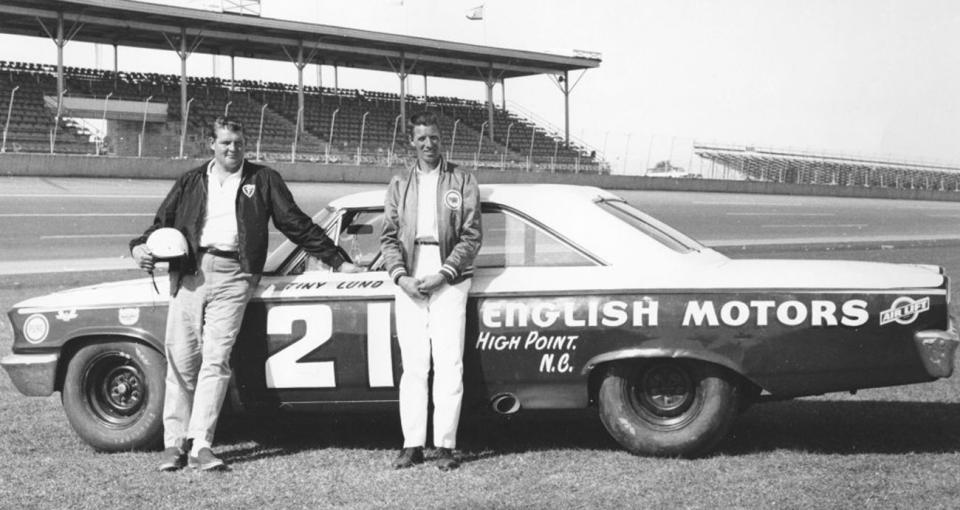
One of the most meaningful victories a driver can have during their career is capturing the checkered flag at their home track. Many drivers grow up attending races there and in turns become an impactful moment when they can be the one that everyone in the stands is watching triumph over the rest of the field.
Cale Yarborough arrived at the track in 1968 on a hot streak, while driving a limited schedule in the No. 21 car for Wood Brothers Racing.
He had made just 11 starts for the team but Darlington was the 39th race on the series schedule. Yarborough made waves by winning the Daytona 500 from the pole, while also notching wins at Atlanta, Martinsville and another at Daytona.
The No. 21 car qualified second for the race at Darlington and the story quickly turned to how big of a moment it would be for Yarbrough to win at the track in which he lived just 10 miles away from.
Reporter Chris Economaki asked Yarborough before the race if it made any difference how he drove a race in what was basically his own backyard.
“I think it does Chris,” Yarborough said. “Maybe I try a little too hard here. I‘ve never done anything here. We‘ve run pretty good but it always seems like something happens. Maybe it‘s because I am trying too hard here at home for the home folks but we are going to try to do something about that today.”
Yarborough did just that.
He led 169 of the race‘s 334 laps, holding off David Pearson in the process, to capture his first victory at his home track.
After the race, Yarborough was ecstatic over the moment.
“This is the happiest day of my life.” Yarborough proclaimed from the cockpit of his car, as he drove his battered car to Victory Lane. “To do it at home, that makes it better than anything in the world.”
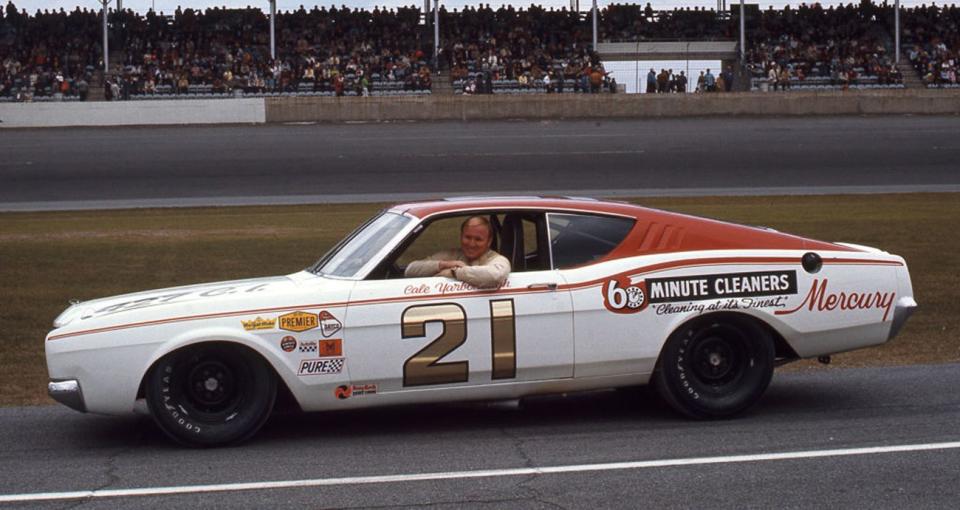
The second race of the 1976 season was broadcasted live. Lead announcer Bill Fleming openly proclaimed at the start of the broadcast that it could be one of the most exciting races of the year.
Little did Fleming know is that the race would go down as one of, if not the most exciting finish of all-time.
Fast forward to the finish of the race, which saw Richard Petty take the white flag just mere inches in front of the No. 21 car of David Pearson. By the time the two cars hit the backstretch, Pearson dramatically dipped below Petty, with his Wood Brothers Racing car tucked against the apron.
It looked like Pearson was going to sail past Petty but a slow car forced Pearson to slide up the track, allowing Petty to make a move for the lead as the cars entered the third turn. Petty got loose and slid into Pearson, sending the No. 21 car head on into the wall.
Petty then lost control of his car and mirrored Pearson, slamming into the wall just a few hundred feet in front of Pearson, with the start/finish line in his sights.
Petty‘s car came to a rest roughly 100 feet shy of the line, but he couldn‘t refire his car. His crew started sprinting across the infield to try to help him get across the line. At the same time, Pearson limped his car through the grass and took the checkered flag.
Petty‘s team pushed their car just enough to be able to get him across the line to finish in second.
Neither driver was upset with each other after the race, chalking it up to two drivers racing hard for glory in one of the biggest races in the world.
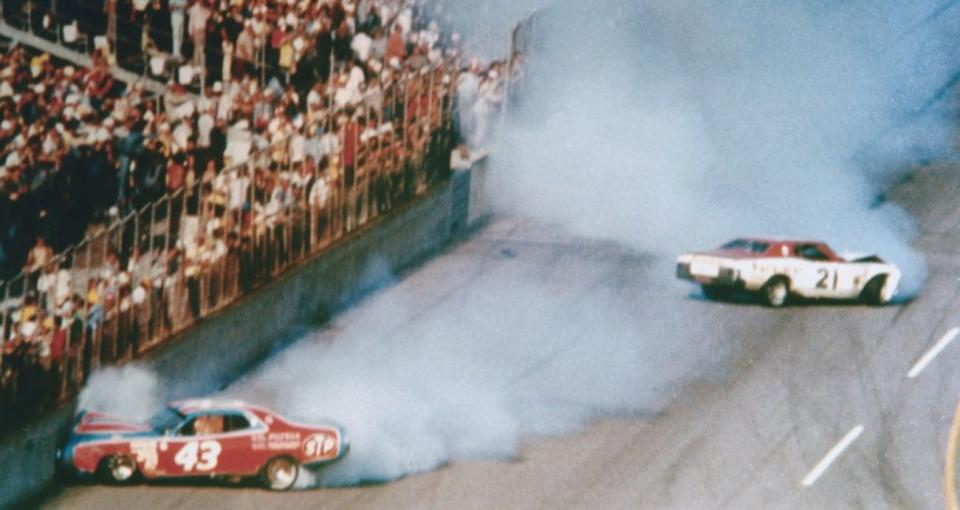
It seemed like the Wood Brothers Racing team had a flair for the dramatic in the Daytona 500, as their victory in 2011 went down as one of the biggest Cinderella stories in NASCAR history.
Nothing on paper had the team having any sort of realistic shot at winning the race. They hadn‘t captured a victory since Elliott Sadler took their No. 21 car to Victory Lane at Bristol in 2001. Trevor Bayne was piloting the car, which was set to be just the second start of his career. He celebrated his 20th birthday the day before the 500-mile event.
Fast forward through the chaotic event to the 197th lap, following the 15th caution flag of the day.
David Ragan was sitting first and Bayne survived all of the incidents to sit in second.
The green flag waved on Lap 202 for a green-white-checkered restart but Ragan was quickly black-flagged for changing lanes before the start-finish line.
Bayne inherited the lead and stayed out front thanks to a push from future Hall of Fame driver Bobby Labonte. The duo held off a late charge from Carl Edwards and David Gilliland, as NASCAR on FOX‘s Darrell Waltrip iconically captured the moment from the broadcast booth.
“Trevor Bayne is going to win the Daytona 500! Happy Birthday, Trevor Bayne! 20-years-old!”
The broadcast quickly cut to radio chatter between a stunned Bayne and his team.
“Are you kidding me?”
Adding to the lore of Bayne‘s popular victory was that he was driving a car reminiscent to the one that Pearson limped to victory in at the track in 1976.
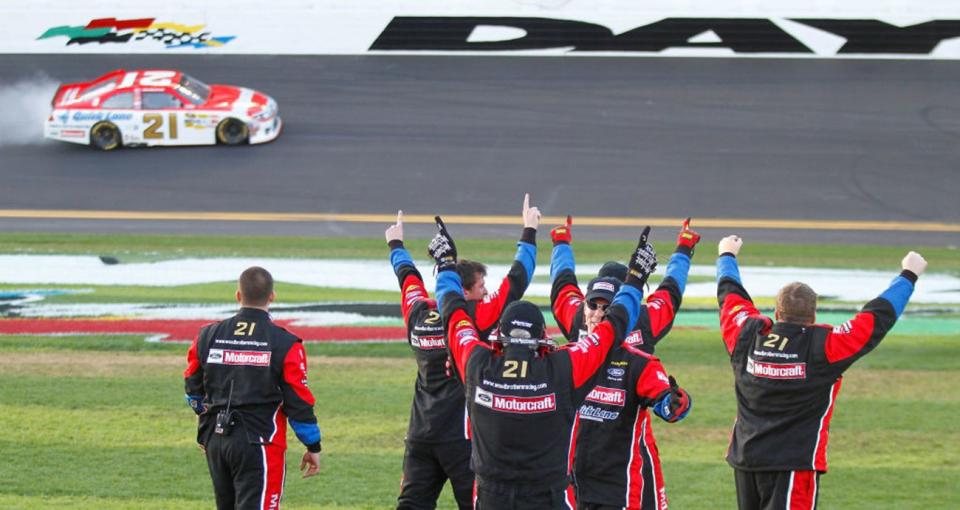
The most recent time that the Wood Brothers Racing team visited Victory Lane came at Pocono in 2017, with a future NASCAR Cup Series champion capturing the first win of his career.
Kyle Busch dominated the race, leading more than 100 laps but a decision late in the race not to pit for fresh tires backfired on a late restart.
Ryan Blaney slipped underneath Busch, as the two battled it out for the victory with under 15 laps remaining. The two made contact, as Blaney‘s fresher tires prevailed as he took the top spot.
The young driver held off a late push from Kevin Harvick to capture the first victory of his career. It was also the 99th win in team history.
It was the first time the team was victorious at Pocono Raceway since Neil Bonnett won the 1980 Coca-Cola 500 at the track.
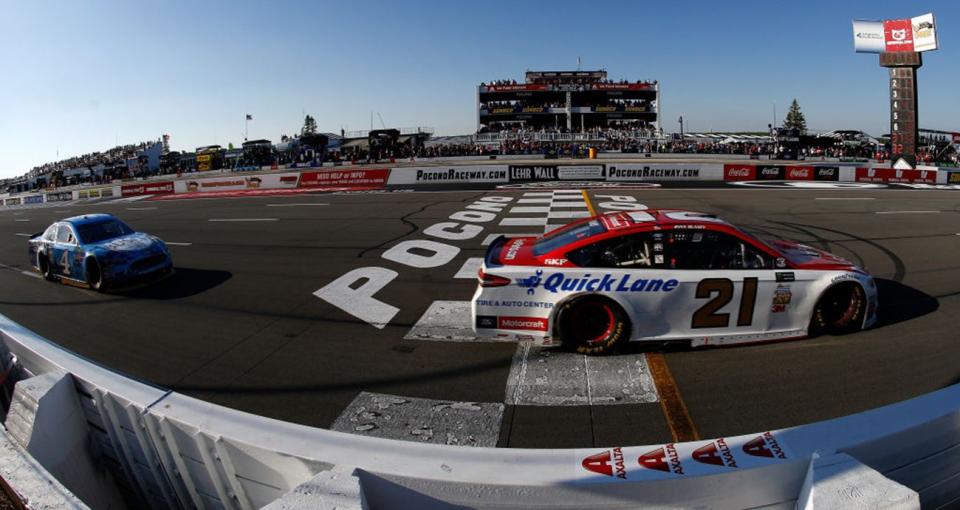
You can watch these three races and hundreds more by visiting NASCAR Classics.

